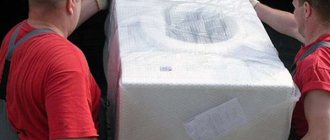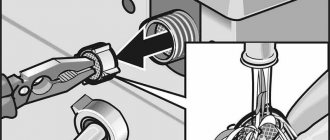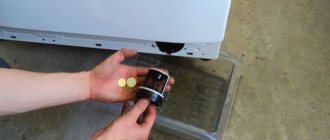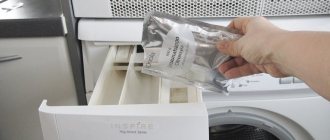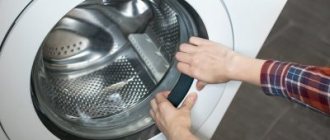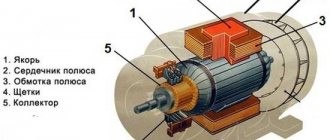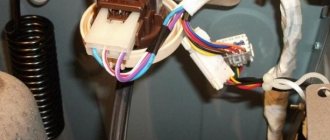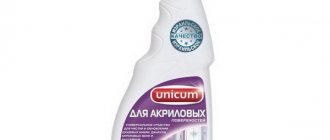How to clean the heating element in a washing machine
The heating element in the washing machine is responsible for heating the water for high-quality and efficient washing. Unfortunately, it most often fails. There are two main causes of failure: short circuit and scale. As a result of a short circuit, the heaters or their contacts burn out; when scale occurs, the element overheats and fails.
After reading the article, you will learn how to clean the heating element of a washing machine from scale.
How to clean the heating element?
If you have not taken preventive measures and scale has appeared on the heating element, you can get rid of it using chemical cleaning agents or mechanically by disassembling the device and performing physical descaling steps. Let's talk about these methods in more detail.
Washing machine repairs are best left to professionals.
We present to you our unique catalog of private masters and service centers - BigWash.ru
Select your city and artist in the filter: by rating, reviews, price!
Using cleaning products
To protect things from the effects of chemicals, it is recommended to use chemicals to combat scale during idle runs with high water heating temperatures. This way you can achieve maximum efficiency in dissolving deposits with reagents and cleaning agents.
Existing scale can be partially or completely removed using folk remedies or expensive cleaning products, the effectiveness of which is approximately the same. For example, you can use Calgon, which performs both a preventive function and helps get rid of existing scale. Based on the practice of use, the product effectively dissolves only a thin layer of scale, and in case of large accumulations of scale, mechanical cleaning is recommended.
In other chemicals, as a rule, the main component is sodium tripolyphosphates. The substance only reduces the level of water hardness, but it does not have the property of dissolving salt deposits.
Mechanically
One of the simple and cheap methods of removing scale that has formed is physical cleaning of the heating element, which allows you to almost completely eliminate deposits on the heating element. To do this, you will need to partially disassemble the washing machine, remove the heating element and carefully clean it of scale using a spatula. This must be done with scraping movements, but at the same time try not to catch the metal, but only remove the layer of plaque.
When cleaning the heating element with a spatula, it is necessary to perform all movements as delicately as possible so as not to damage the heating element or disable it.
Why does plaque appear?
Scale on heating parts occurs due to hard water. When water exceeds the content of insoluble calcium and magnesium biocarbonate, it leaves a sediment. It sticks to the heating element and other parts of the washing machine.
Should you be afraid of scale?
If scale is not removed in time, then over time the heating element becomes so overgrown with it that it ceases to function normally. Besides:
- To effectively wash in hard water, you need to use more detergent. It is known that clothes are washed better in soft water.
- When plaque forms on the heater, it prevents it from delivering the proper amount of heat. Therefore, much more electricity is consumed to heat the water.
- A burnt heating element can cause a malfunction of the electronics, control board elements, and wiring. Such repairs will cost much more than timely cleaning of the element.
Moreover, flying pieces of scale during washing end up in the drum and drain pipe, which can lead to serious damage. Therefore, it is important to know how and how to clean the heating element in a washing machine from scale.
Famous cleaning products
In stores and markets you can find a large number of cleaning products from various manufacturers. The most popular and advertised is Calgon, which supposedly prevents the appearance of scale in the SMA.
Studies have proven that Calgon has minimal impact on water quality. Therefore, the plaque will still settle on the parts, just a little slower.
Every manufacturer who advertises their product and knows how to remove scale from heating elements uses marketing techniques. Simply put: every expensive product contains regular citric acid. So what's stopping us from using it at home?
The whole truth about Kalgon
Thousands of housewives, believing the advertisement, rush to purchase this product to prevent scale. After all, none of them wants expensive equipment to fail. But is it really that effective? Professionals answer that Calgon belongs to ordinary water softeners. It contains soda and sodium triphosphate. One box of product costs three times more than the cost of the components.
The fact is that it is not reliable protection for the heating element. On the contrary, it only brings damage. If you constantly use this product, the surface of the heating element will become as hard as cement. This layer is much harder and more durable than magnesium and calcium scale. Therefore, you should not be surprised if the heating element quickly burns out.
Instead of the promoted Calgon, it is better to use ordinary modern powders, to which manufacturers add a softener and other substances that care for the washing machine. In addition, scale prevention will be much cheaper.
Removing scale at home
Take citric acid to clean the heating element in the initial stages of contamination or for prevention in new washing machines.
- Add 150-200 g of citric acid to the dispenser in the powder compartment.
- Now select the longest wash cycle without spinning, with a water temperature of 60 degrees.
Note! Cleaning with citric acid is carried out in an empty washing machine. Therefore, empty the tank of laundry in advance.
- Wait until the cycle finishes before descaling. Now open the loading hatch.
- By bending the rubber cuff, remove pieces of scale and debris from the cracks.
- Wipe the inside of the drum thoroughly with a microfiber cloth that absorbs water well.
It is important to perform this cleaning regularly, since a single application will not protect the elements from further damage by plaque. It is recommended to use citric acid once every three to four months.
We use chemistry
Chemicals for descaling heating elements are as effective as they are dangerous if used incorrectly.
How to do it right:
- Add the product according to the instructions to the CM drum.
- Set the temperature to 60-90 degrees, start washing without laundry.
- Clean no more than once a month.
The danger of chemicals is that exceeding the dose can damage the rubber elements of the washing machine. For example, cuffs, hoses. The chemical will corrode the rubber, leading to loss of seal and leakage.
Another danger of chemicals: if the heater is heavily damaged by plaque, pieces of it during such cleaning can stop the operation of the MAS or clog the drain tract.
In this case, it is better to remove the heating element from the car and then start cleaning it.
Advice from experienced housewives - a selection of the best folk methods for solving the problem
Almost all effective cleaning products that are used to remove scale contain some kind of acid. It is this that combines with salts dissolved in water and then reacts with them. This is how descaling occurs.
Experienced housewives use these store-bought products to treat their washing machine.
We list the most popular cleaning methods:
- Citric acid is placed in a container intended for detergent. You need to take 100 grams of lemon powder. After this, select the longest laundry program. It is important that the water temperature is not lower than 60°C.
- In the evening, citric acid is poured into the detergent tray. Then a wash cycle with a temperature of at least 90°C is selected. In the very middle of the process, the washing machine must be stopped by cutting off its access to electricity. The machine, disconnected from the network, should remain in this state until the morning. This time will be enough to clean the drum and ten. In the morning, the washing machine connects to the network again and continues to work from the moment it was stopped.
- You need to add white to the citric acid and run the longest wash cycle. The water temperature must be at least 90°C. Please note that when choosing this method of cleansing, you need to take care of ventilation. Good ventilation should be not only in the room where the unit is installed, but in all rooms. It is advisable that there are no people in the apartment. Chlorine fumes can cause health damage. They also negatively affect human mucous membranes.
- Acetic acid is used to clean the machine from scale and dirt. You need to pour 50 to 100 ml of vinegar into the detergent tray. Then select the longest streak mode. The water temperature must be at least 60°C. This method is very effective, but it is also considered aggressive. To achieve the best result, the operation of the machine is interrupted for one hour, then the cycle should continue again.
- Fungus and mold on the drum can be easily removed with a soda solution. Ratio: 250 grams of soda are diluted in 250 ml of water. The resulting solution is used to treat the inner surface of the drum.
- Chlorine-containing products help fight mold spores. You can use bleach or any other bleaching agents. 100 ml of white should be poured into the drum and run an idle wash for 30 minutes. The water temperature must be at least 90°C. It is better to leave the apartment at this time, leaving the windows open.
- Another rather unconventional method. In 100 grams of warm water you need to dilute 50 grams of copper sulfate. Mix the resulting mixture well, then pour it into the drum. Select a wash cycle with a temperature of 90°C and start it. 30 minutes will be enough for cleaning.
How to get the heater
For front-loading washing machines, the element can be located in both the front and back.
Try to visually determine where the heating element is by inspecting the front and back panels. Usually it is hidden behind a wider lid.
To remove the element, remove the CMA panel.
- Remove the top cover by unscrewing the two bolts at the back.
- Pull out the dispenser tray by pressing the latch.
- Unscrew the control panel screws and lift it up.
- Remove the bottom cover, unscrew the screws there.
- Open the hatch door, bend the cuff, remove the metal clamp.
- Disconnect the wires of the electronic lock (UBL).
- Remove the front panel.
The heater in this case is located under the tank. You need to press out all the connectors leading to it, loosen the central nut and push it inward.
To remove the back cover, you only need to unscrew the mounting screws to get to the element.
How to remove scale? To do this, remove the temperature sensor from the heating element and rinse it under running hot water. Remove the pieces of stone that are removed by hand. Do not forcefully scrape off the scale, otherwise you may damage the body.
- Take a two-liter plastic bottle.
- Cut off the neck and fill the container with hot water.
- Dissolve three to four tablespoons of citric acid in water.
- Place a heater there.
- Leave it for a day.
The acid breaks down the components of the water stone. After that, all you have to do is remove the coating - and you will get a clean part.
Then install it in place and do not forget about prevention.
How to avoid scale formation
As you understand, water softeners are not always effective. It is much more profitable to install a magnetic softener. This device allows you to efficiently break down salts that form sediment in water. Consequently, plaque will not settle on the parts of the washing machine.
It is located on the inlet hose or water pipe.
Don't forget that softened water requires less detergent than hard water. Therefore, be careful not to cause increased foaming in the SM.
It is recommended to wipe the inside of the washer and the cuff after each washing cycle. Leave the door open to allow the machine to dry.
Now you know how to clean the heating element in a washing machine. The main thing is not to delay, and to carry out timely scale prevention. You may not be able to use other water, but you can certainly use our tips to improve its quality.
A video on the topic will help you:
How to clean the heating element of a washing machine from scale and why it appears
When the washing machine becomes dirty, namely when scale appears on the heating element, the question arises of how to clean the heating element of the washing machine from scale.
For different SMs, the heating element can be located both in the front and in the back. If you need to clean the heating element, you first need to understand where it is located in this particular machine model. If there are no instructions where this is shown schematically, then its location should be visually determined.
Most often, heating elements are located behind a wide cover. In order to remove the heating element from the washing machine, you need to remove the CMA panel.
If the heating element is located in front, then it is necessary:
- Unscrew the two screws at the back and remove the decorative cover located on top;
- By pressing the latch (sometimes you need to turn the lever), remove the detergent dispenser container;
- Lift up the control panel by unscrewing the screws;
- Remove the bottom cover in the same way by unscrewing the bottom bolts;
- Having opened the hatch, bend the cuff and remove the metal clamp;
- Release the terminals of the UBL (hatch blocking device) from the wires;
- Finally, remove the panel covering the front of the heating element.
In this case, the heating element is located at the bottom of the tank. Therefore, to get it, you need to loosen the nut located in the center, move the connectors leading to the heating element and push the nut inward. After this, you can remove the heating element from the machine.
If the heating element is located behind the back wall of the machine, as in many Samsung models, then you only need to unscrew the mounting screws to remove the heating element.
Before cleaning the heating element from scale, it is necessary to remove the temperature sensor from it and wash it in hot water. You should remove all easily breakable stones by hand, never using hard objects to avoid damaging the body.
Lemon acid
Pour hot water into a plastic bottle or other container with a volume of about two liters, after cutting off the neck. Citric acid, in the amount of 3-4 tablespoons, must be dissolved in water. Place the heating element inside the bottle and leave for a day.
The water stone formed on the heating element must be dissolved by the acid. After the heating element is removed from the container a day later, all that remains is to remove the deposits from it and wipe the clean part. The heating element is installed in its original place.
Vinegar
To destroy scale in SM, you can use vinegar. This is also a fairly economical option.
Pour 2 cups of 9% vinegar into the washing powder container and wash in an empty machine at high temperature on the longest cycle. After the machine has filled with water, it must be stopped and allowed to stand for about 1 hour. During this time, the process of destruction of scale on the internal parts of the machine should begin.
After an hour, you need to start the machine and continue washing on the shortest cycle. This is necessary so that the internal parts of the machine are rinsed from residual vinegar and scale.
You shouldn't clean your car with vinegar often. Once every six months is enough. And to eliminate unpleasant odors, you can add a little vinegar to the detergent tray when washing rough items.
Cleaning heating elements from scale: instructions
How to clean the heating element of a washing machine from scale at home? The first, simplest, most affordable and effective way is to run the wash in maximum mode at a temperature of 90oC without clothes, but with citric or acetic acid. Stronger acids, such as hydrochloric or sulfuric acid, are not recommended because they can cause metal corrosion. And they require stronger safety precautions when handling them.
Citric acid can be used in its pure form; it is sold as crystalline powder in bags in grocery stores: 1 g per 1 liter of water. Acetic acid must be diluted 1:10 or use 9% table vinegar. In an acidic environment at high temperatures, scale peels off relatively quickly and easily and goes into the sewer along with the water in the drain mode.
After carrying out such cleaning, it is advisable to run the machine in rinse mode to clean it of any remaining acidic environment.
The alternative mechanical cleaning method is more labor-intensive and potentially dangerous for the heating element, because removing hard scale can damage the metal tube of the element.
To clean the heating element of a washing machine from scale, according to the instructions, you do not need to remove it from the drum tank. You just need to use one of the gentle chemical reagents (vinegar or citric acid) in the washing mode at a temperature of about 90oC, of course without laundry.
Other reagents
In order to clean the heating element, you can also use chemicals. However, it should be remembered that they are equally dangerous if safety rules are neglected, as they are effective.
To properly clean the heating element using chemical reagents you need:
- Pour or pour the product into the drum of the machine;
- Set the washing mode at 60-90 degrees and start it without putting laundry in the drum;
- For preventive purposes, repeat this procedure monthly.
Chemical reagents are also dangerous because an overdose leads to the destruction of machine parts made of rubber or delicate plastics. Such as hoses and cuffs. If the rubber is corroded, the parts lose their tightness and elasticity, resulting in a leak in the washing machine.
Chemicals should be used with extreme caution, because if large pieces of plaque clog the drain system or stop the machine from operating, this can lead to electronic failure or leakage. If this does happen, then you need to immediately remove the heating element from the machine and clean it.
Causes of scale
The cause of scale on the heating element is hard water and mineral salts dissolved in it. When the content of magnesium and calcium biocarbonate in the water exceeds, sediment remains. It is this that settles on the heating element and other parts of the SM, leading to breakdowns and leaks.
When washing in hard water, more washing powder is required. And in soft water, clothes are washed much more efficiently.
If plaque appears on the heating element, it does not allow the element to transfer the heat necessary for washing to the water. As a result, more electrical energy is required to heat the water.
If the heating element burns out, the electronic board or its elements may fail and this will result in costly repairs.
Scale damage
Tap water contains dissolved salts and the higher their percentage, the harder the water.
The main role in the formation of scale is played by calcium and magnesium salts. When water comes into contact with the surface of a hot heating element, the salts dissolved in it decompose into insoluble sediment (scale) and carbon dioxide, which simply evaporates. The surface of the heating element is made of stainless metal, which has excellent heat transfer and almost instantly transfers thermal energy to the heated water. But in real operating conditions, such an idyll ends relatively quickly. Depending on the water hardness level.
With each wash, the metal surface of the heating element is covered with a layer of scale, creating thermal insulation. Over time, the thickness of the heat-insulating scale crust becomes so significant that the machine begins to heat the water for too long. This not only increases the washing time, but also increases the consumption of electrical power.
Another negative effect of scale is that it has a destructive effect on the stainless tube of the heating element itself, as a result of which sooner or later the heating element is destroyed, its tightness is lost, which leads to a short circuit. Which in turn can lead to damage to other electrical and electronic components of the washing machine.
Pollution prevention
As a preventive measure, it is easier to use citric acid to clean the heating element.
Prevention is performed as follows:
- A glass of citric acid is poured into the washing powder tray;
- The longest wash cycle is selected, without using a spin cycle, at a water temperature above 60 degrees. Important: cleaning with citric acid is carried out without putting laundry in the drum.
- Before descaling, you must allow the machine to finish the selected wash cycle;
- The loading lid is opened and, by bending the cuff, pieces of water stone, dirt and debris that have fallen there are removed;
- The drum is wiped with a soft cloth that absorbs water well.
It is important to carry out such preventive actions regularly, without leading to the appearance of a thick layer of deposits on the heating element. At least four times a year.
To prevent scale formation, you can use a magnetic softener. It is more effective than commercial water softeners.
This device quickly breaks down salts that form sediment in water. Thus, plaque will not remain on the components of the washing machine.
A magnetic softener is installed at the cold water inlet of the washing machine on the hose itself or on the water supply.
When using a water softener, it is necessary to take into account that when washing clothes in soft water, less washing powder is required than in hard water. Otherwise, increased foaming will occur and you will have to stop the wash cycle and remove the foam.
After each wash, you need to wipe the machine, its inside, especially the cuff dry. The door should be left open until the machine is dry.
Causes and consequences of pollution
It is really necessary to clean your automatic machine. You should also know what exactly needs to be washed. If you look inside a device that has been in use for a long time, the first thing that catches your eye is the dirty residue that has formed on the metal and plastic elements. It contains minerals, so it is often hard and cannot be easily cleaned mechanically.
The causes of plaque are as follows:
- The water entering the machine is hard or dirty.
- The powder contains many chemical components.
- The equipment is constantly operated in intensive washing mode.
Many corners of the washing machine are difficult to reach, and this is where dirt accumulates. Cleaning it is quite a difficult task, since the hand cannot reach such places, and using various sharp instruments is dangerous. This is the reason for the layering of dirt, which is why the home assistant soon becomes unusable . It breaks, and repairing it is not cheap. This leads to the conclusion that you shouldn’t go to extremes, but rather find out in advance how to descale a washing machine and disinfect its drum and tank. If measures are taken in time, the life of a domestic helper will be significantly extended.
Hard water contains a lot of magnesium and calcium salts. When heated, they turn into carbon dioxide and solid sediment. Then the latter, together with dirty particles, for example, rust, settles on the heating element and the tank of the machine. A heating element covered with a crust of scale conducts heat worse, as a result, the water takes longer to heat up, while the amount of electricity increases. And sediment from the water clogs the inlet valve, causing its parts to become unusable ahead of time.
More dirt gets into the machine after turning off the water and repairs .
To find out whether scale has accumulated on the heating element or not, you should look into the device of the machine. As a rule, the heating element is located under the drum or slightly offset from its center to the side. Armed with a flashlight, you need to illuminate the holes in the drum and try to see the heating element. To ensure uniform lighting, you can lightly shake the drum. It may not work out right away, but by choosing the right swinging speed, you will eventually be able to consider the heating element.
How and with what to clean a washing machine: the best methods + review of special products
Do you want to extend the trouble-free operation of your washing machine by cleaning its main elements? Agree, it’s great when the washing machine works like a clock: load the laundry, pour in the powder, press start. To do this, it is worth remembering the most important thing: any equipment needs care.
But the range of detergents is very rich and you don’t know which of them can cope with the task? We will help you figure out how and how to clean your washing machine from a variety of contaminants - from scale to banal dirt and the ubiquitous fungus.
The article discusses effective methods of cleaning the heating element with an overview of the most effective means. To avoid breakdowns of expensive appliances, floods and other consequences of oversight, we offer step-by-step instructions on how to perform comprehensive cleaning of all important components and elements of the washing machine.
We have selected photos depicting important stages of the process, as well as useful videos demonstrating the prevention and maintenance of the unit on our own.
Why should you clean your washing machine?
Although the purpose of the machine is to “give” us clean things, the condition of the device itself may be far from sterile.
Dirt removed from clothing during washing accumulates on the internal elements. Black spots of mold can often be replaced on the sealing gum and the edges of the drum, because heat and moisture are ideal conditions for the development of fungal organisms.
And the heating element and other parts are gradually covered with a coating of salts that are in the water.
Main sources of pollution:
- high mineralization of water;
- use of aggressive chemicals and low-quality detergents;
- improper operation of the device;
- washing heavily soiled items - overalls with residues of mortar or machine oil, clothes after gardening work, etc.
So, in order to bring your assistant into a perfectly clean appearance, it’s time to do some general cleaning, starting from the body itself and ending with the internal parts.
To wash away obvious external contaminants (stains of gel, conditioner, traces of powder), warm water and a sponge are enough. But you will have to work hard with the parts hidden in the depths of the unit.
We remove scale from the heating element and internal elements
One of the most serious accidents that can easily happen if you do not properly care for your washing machine is the failure of a tubular electric heater.
Since the heating element is in contact with running water, scale forms on it after each wash - deposits of calcium and magnesium salts.
Therefore, if a softening filter is not installed in the drain, it is recommended to add special agents to the powder (for example, Calgon) and carry out preventive maintenance at least once a month.
Method #1 - improvised materials from stocks
One of the simplest and most effective ways to combat lime deposits is to pour tribasic carboxylic or citric acid into the powder compartment and turn it on at any high temperature setting.
This recipe works simply: when heated, the acid actively corrodes not only light deposits, but also caked limestone, as a result of which it cleans both the heating element and the steel of the drum.
Calculation of the required amount of powder must be done based on the degree of contamination of the machine and its container. On average, for every kilogram of loading there is about 25-30 grams of acid.
If the unit has not been cleaned for a long time, you can take note of the following advice: pour acid into the powder container, run any long washing mode with a temperature of 90°C and above and turn off the power from the network halfway through the process. Leave it overnight and start the machine again in the morning.
It is recommended to use this procedure no more than 4 times a year, and after each time you must check the drain hose and drum cuff to remove large particles of loose limestone.
Other home remedies and their uses:
- Table vinegar - pour 1-2 cups of a 9 percent acetic acid solution into the detergent cuvette, select a high-temperature mode with long washing and pre-soaking. To get rid of the specific sour smell, you can then turn on an additional rinse.
- Baking soda and vinegar - to enhance the effect of acid on limescale, a special solution will be useful. It is prepared like this: half a glass of soda is mixed with the same amount of water and placed in a container for powder, and 1 glass of 9% vinegar is poured into the drum. Then the machine starts in any long-term mode at maximum temperature.
- Bleach and other chlorine-containing products are used in the old fashioned way by many housewives for comprehensive cleaning and disinfection of the washing machine.
But in fact, the effectiveness of caustic preparations is very doubtful: they will not save you from scale, but some elements (for example, the rubber drum seal and various sealing gaskets) can cause great damage. And chlorine vapors are harmful to health.
But we looked at the most reliable, cheap, safe and practice-tested methods for getting rid of scale using improvised means.
Method #2 - special chemicals
The cleaning agent for washing machine elements must be safe for humans, fabrics and all internal surfaces of the device, and also effectively remove lime deposits and other contaminants.
Specialized preparations have an important advantage over “folk” ones - their composition is developed taking into account the design features of the device and does not harm some elements while cleaning others.
- Topperr 3004 (Germany) – descaling cleaner, suitable for dishwashers and washing machines. It removes scale of varying degrees well, recommended by Bosh manufacturers.
- Schnell Entkalker is a powder for quickly cleaning internal elements from stubborn lime deposits. Produced in Germany, available in 200g packs.
- Antikalk for Washing Machines from Sano (Israel) is a universal gel for the prevention and elimination of small plaque with an antibacterial effect.
- Magic Power (Germany) is one of the best specialized products for washing machines. Available in the form of gel and powder, which effectively removes plaque from heating elements, tanks, and drums.
- Beckmann (Germany) is a universal product that will protect against scale and eliminate unpleasant odors caused by various contaminants. But, like any multi-purpose product, it is good for regular care, but will be ineffective against heavy dirt.
- Filtero 601 (Germany) – works well to remove old scale from the heater and other elements; it is recommended to use 3-4 times a year for intensive cleaning of the machine. Available in 200 g bags for one use.
- Doctor TEN (Russia) and Antinakipin (Belarus) are analogue powder preparations intended only for removing scale, but from any equipment. An inexpensive and convenient solution to the problem of lime deposits on the heating elements of both washing machines and dishwashers.
Please note that many products that, judging by the advertising, are guaranteed to protect our machine from problems with plaque, will not get rid of existing scale, but will simply reduce the concentration of salts in the water, for example, the same Calgon.
It is easy to distinguish between them - it is recommended to add such preparations before starting the machine along with the powder or directly into the drum, and they are used when washing things.
Method #3 - manual cleaning
If you have never thought about how to clean your washing machine and all its key elements before, and the assistant has served you for more than one year, it is recommended that you first carry out a visual inspection of the heating element.
Most likely, a multi-layered limestone has already formed on the heating element, which will be easier to remove manually - with standard cleaning methods, broken-off solid plaque particles may remain inside the unit.
To clean the heating element we proceed in stages:
- Disconnect the wires, sensor and remove the heating element. Scale and dirt can interfere with the process, so after loosening the fastening, carefully pry up the metal flange with a flat-head screwdriver. But be careful and proceed smoothly so as not to damage the tank itself and the wiring.
- We rinse the heating element under good pressure with warm water to remove loose deposits and dirt.
- We make a concentrated solution to remove stone residues: pour 3-4 tbsp into a plastic bottle with a cut off neck. citric acid powder, place the heating element inside and fill with hot water to the level of the bar.
- Shake the liquid to activate the cleaning process. Rising air bubbles will indicate that magnesium and calcium salts have begun to dissolve.
In this state, we leave the heating element to soak overnight. And in the morning, we rinse the metal under running water with a soft sponge, wipe it dry, admire the glare of light on the sparkling stainless steel and install the element back into the device.
By the way, if you take the machine apart, you can also inspect the condition of the drum. You may have to dismantle it too in order to thoroughly clean all the holes and remove scale and mold.
But you shouldn’t do this without extreme necessity and skills in working with equipment; you can get by with treatment with a good special tool.
Top best ready-made cleansers
The deposits that form on them pose a huge danger to the internal parts of your unit. Companies involved in the production of washing machines recommend using special preparations to clean the drum, heating element and other parts of the machine. The cleaning ability of these products is based on the presence of a strong acid in their composition. Therefore, they should be used only when a white coating appears.
We list the most effective drugs that help clean the washing machine from dirt and scale.
Magic Power
It fights well against complex types of scale that have accumulated on the drum and heating element due to prolonged use of the unit. Country of origin: Germany. It is considered one of the most effective remedies. Particularly suitable for use in regions where the water contains various salts, impurities and has a high level of hardness. The drug contains citric acid.
- It is enough to apply once every 6 months.
- High efficiency.
- Comfortable to use.
- The product contains no aggressive chemical elements and is non-toxic.
Topper
Leading washing machine manufacturers – Bosch and Miele – developed this product jointly for their products. The drug quickly copes with even very large deposits of scale on the heating element and filter. It is recommended to apply Topper three times a year. One package, weighing 125 grams, is enough for one procedure - the powder is poured into the drum and a “idle” wash is started. The water temperature must be at least 60°C.
- Complex impact.
- Removes dirt well.
- Dissolves salt deposits formed on the heating element.
- Affordable price.
- You can fix the problem with one cleaning.
- Ease of use.
- There is no pungent odor after use.
- Suitable for dishwasher cleaning.
Top House
Quite an effective product that perfectly removes dirt and scale from parts of the washing machine. One bottle contains 500 ml of product. This makes it possible to carry out up to five cleanings per year.
- The product is quite economical.
Antiscale
Available in powder form. Country of origin: Russia. Cleaning is carried out during a “idle” wash, at a temperature of 30 to 40°C. Two packages of this product are poured into the powder compartment. It will take about 40 minutes to remove the middle layer of scale. The formula is based on diluted vinegar essence.
Pros:
- Suitable for both cleaning washing machines and removing scale from kettles.
- Does not harm rubber elements.
- Doesn't clog the filter.
- There is no pungent odor left after use.
- Easy to use.
Minuses:
- Cannot be used more than once a month.
- The product is very caustic; you only need to work in it with gloves to avoid chemical burns.
South Korean powder that removes lime deposits well. One package is enough for 4 cleaning procedures.
Pros:
- The product is quite effective.
- Economical.
Minus:
- Difficult to use. Before use, the powder must be diluted with water.
Procedure for comprehensive cleaning
In addition to scale, there are other problems that can be caused by improper operation of the machine: dirt, unpleasant odor, mold. Therefore, you should regularly maintain the cleanliness of the internal elements.
Step #1 - wash the drum
After each wash, residual water and dirt remain in the drum. And soon black spots appear in the folds of the sealing cuff, and a musty smell comes from the depths of the machine.
Starting at idle speed with the addition of disinfectants or regular citric acid will help solve the odor issue. But the gum needs to be thoroughly cleaned by hand.
The easiest option is to carefully push the folds apart, wash the cuff around the circumference with a sponge, soap and warm water, and then wipe dry.
If you notice mold stains, you can use a solution of copper sulfate or prepare a cleaning paste of water and baking soda in equal proportions.
Then thoroughly treat the elastic band and the entire drum with this mixture, leave for a couple of hours, and then wipe with a sponge and start the long-term wash cycle.
For more information on cleaning your washing machine drum, see this article.
Step #2 - clean the filter and drain hose
The cause of an unpleasant odor can also be debris invisible to the eye - hair, particles of soil or building materials, lint, feathers and various small objects that were not removed from clothing pockets in time.
All this accumulates in the filter and hose through which the machine releases waste water. It is recommended to clean the washing machine drain filter at least once every 3 months, and more often during active use.
To do this, you need to remove the protective panel, place a small container for draining water or place a rag on the floor. Then unscrew counterclockwise and remove the filter. Rinse it under high pressure water and remove accumulated debris from the hole.
To rinse the hose, you need to drain the remaining water in the machine through the drain filter and then disconnect it from the entrance to the sewer pipe or siphon. After this, you can remove the part, but exactly how to do this depends on the design of the device itself.
For example, in Ariston, Samsung, Indesit, LG, Whirpool, Ardo machines, you can only get to the hose connection through the bottom.
To do this, you need to lay the device on its side, remove the bottom panel and filter, and loosen the clamp with pliers. All that remains is to disconnect the pump and remove the hose itself.
In Electrolux and Zanussi machines, you need to look for the drain fastening behind the rear panel, and in Bosch and Siemens - behind the front, when it comes to front-loading machines.
But for vertical models, you can only get to the hose through the side cover. Therefore, it will not be superfluous to check the instructions, which describe the device diagram.
To clean the drainage hose from dirt and powder deposits, equip yourself with a thin non-metallic cable with a mini brush attached to one end.
We run this brush inside, scroll it and gradually move it to the end of the hose. Then rinse under pressure of warm water. For severe contamination, several passes can be made.
Step #3 - wash the powder container
A rough coating from hard water appears on the walls of the detergent compartment, and traces of powder and various rinse aids remain. All this needs to be removed.
- We remove the cuvette from the compartment and remove the container for the conditioner.
- We rinse under running water, wipe off mold stains with soda or any chlorine-containing product (there are no rubber elements here, so chlorine will not harm).
- Pour a packet of citric acid into a small bowl.
- Place the disassembled cuvette, fill it with hot water and leave for an hour (if it is heavily soiled, it can be overnight).
- Then we remove the remaining plaque with a sponge and thoroughly clean all joints with a toothbrush.
- Dry the container, assemble and place in place.
Another option for dealing with plaque is to fill the removed cuvette with soda and add table vinegar. As a result of the reaction, the soda will foam and soften the lime deposits so that they are easier to remove.
To get rid of dirt and plaque in the container compartment, you can use the same soda paste and toothbrush, and pre-treating the tray with a spray cleaner will help speed up the process.
Rules for caring for your washing machine
If you regularly take care of your assistant, you can do without disassembling the structure and unscheduled replacement of its elements. And to do this you just need to follow a few simple rules.
Recommendations and useful tips for care:
- After washing, always wipe the door glass, drum and rubber band dry, and rinse the powder container under good pressure with warm water and dry.
- If you have hard water in your area, you can equip the water supply hose to the machine with a magnetic filter. The flow will pass through a magnetic field and change the crystalline structure of the water, as a result of which scale simply does not form.
- Wash blankets, sweaters and other fleecy items in a special fine-mesh bag.
- Do not leave wet clothes in the washing machine even for a couple of hours - in addition to the unpleasant smell, the consequences of such forgetfulness will soon appear as black mold spots.
- Promptly remove powder stains, water drips and grease splashes (applies to appliances installed in the kitchen) from the appliance body.
Depending on the time the stain appears, the options for getting rid of it will differ. To remove fresh dirt, simply wipe the plastic with a cloth soaked in water or a solution of dishwashing liquid. And baking soda paste will help deal with old yellow spots and stains.
The frequency of preventative cleaning with home or professional products depends on the quality of the water in your system, the use of softeners and how often you use the washing machine.
On average, the procedure for disinfestation and descaling should be carried out once every 2-3 months. And do not forget to rinse the filter and drum cuff to remove lime particles after all cleaning compounds.
